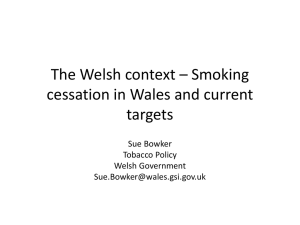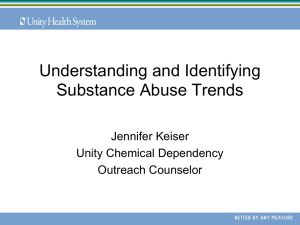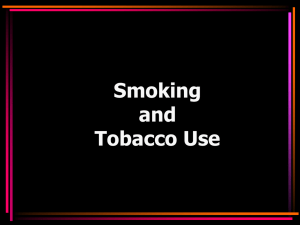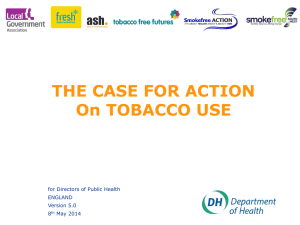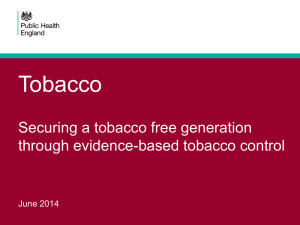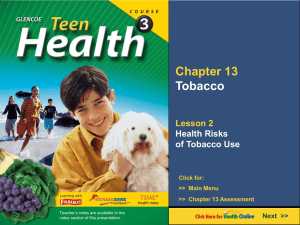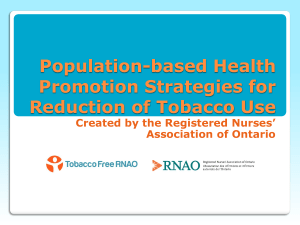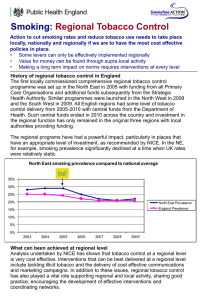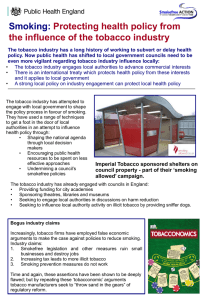Promoting a Tobacco, Alcohol, and Drug-Free
advertisement
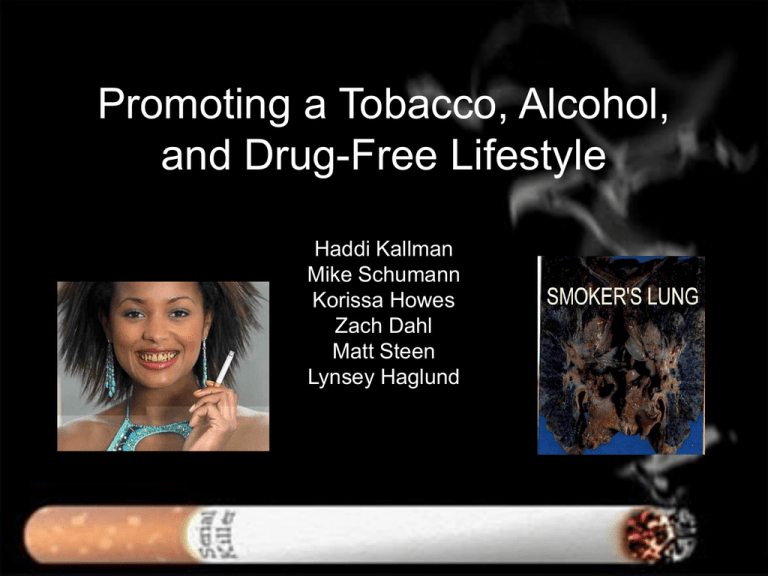
Promoting a Tobacco, Alcohol, and Drug-Free Lifestyle Haddi Kallman Mike Schumann Korissa Howes Zach Dahl Matt Steen Lynsey Haglund Tobacco, Alcohol, and Other Drug Education • Minnesota Survey Results for 6th graders: – 1.5% “smoked cigarettes in the past month” – 1.5% “used marijuana in the past month” – 10% “used alcohol in the past year” • Students tend to over-estimate the amount of drug use amongst their peers Important Background Information about Tobacco, Alcohol, and Other Drugs • Tobacco use typically begins in adolescents by age 16 • The first drug used by young people who use alcohol and illegal drugs is usually tobacco • Students who are struggling in school are most likely to begin using tobacco • Advertisements usually glamorize tobacco use, and many adolescents believe them • Watch Video: http://www.youtube.com/watch?v=v4Ylwj1q9m8&feature=related Important Background Information continued… • Alcoholic drinks contain a depressant called ethyl alcohol • The three main types of ethyl alcohol include: beer, wine, and distilled spirits • Alcohol is a gateway drug along with tobacco • Use of alcohol and drugs can alter judgment, vision, coordination, speech, and can often lead to dangerous behaviors • Watch Video: http://www.youtube.com/watch?v=QNdCi1trDaU&feature=relate d Important Background Information Continued… • Marijuana is most likely the first drug adolescents will use • Smoking becomes more difficult to quit along with use of marijuana • Inhalants, such as aerosols, gases, and nitrites, are legal, everyday products often used by young people to achieve a mind-altering effect or euphoric state Why is it important to teach this unit/area to students in grades K-6? • Eighty-nine percent of people who ever try a cigarette try by the age of 18. It’s very rare that someone will start the habit of smoking during adulthood • 70% of adolescent smokers say they would never have started if they could choose again. • Tobacco is responsible for nearly one in every five deaths in the United States. It is the largest cause of preventable death. • More than 400,000 people die every year from smokingrelated diseases. That’s more than from alcohol, crack, heroin, murder, suicide, car accidents, and AIDS combined Importance of teaching continued… • It’s important to teach kids early on about the dangers and health risks about drug use (drugs including tobacco and alcohol) because the media is so intrusive about the “cool factor” of drugs. • Students who are raised in a family that uses alcohol, tobacco or other drugs unhealthily might not ever hear of the negative side effects of using these substances. Students need to hear the truth about these drugs. • http://www.abovetheinfluence.com/facts/drugs-sources.aspx Various drugs and their effects • On this slide show, we see that anti-smoking campaigns have indeed been helpful. Numbers have been decreasing of those who smoke. The U.S. has been taking steps to get rid of smoking, as we have been recognizing how dangerous and deadly smoking and tobacco use is. • http://www.bam.gov/sub_yourbody/yourbody_smoking_game.html Tobacco, Alcohol, and Other Drug Education • It is important for students to know the facts about tobacco: – 440,000 people die each year from cigarette smoking – Smoking medical bills can cost up to $75 billion per year – Use of tobacco products is the single most preventable cause of death in the United States today • • • • • • • • Cigarettes: Cigarettes contain more than 4000 chemical compounds and at least 400 toxic substances The most dangerous are: *tar, a carcinogen (substance that causes cancer) *nicotine is addictive and increases cholesterol levels in your body *carbon monoxide reduces oxygen in the body Watch Video: http://www.youtube.com/watch?v=3T5S5Ze5bRQ How are K-6 students impacted by health problems related to this unit/area? • Tobacco • – The body: – *cataracts in the eye, – *gum disease (you lose your teeth) – *Ulcers (holes in your body) – *Stroke (your heart stops) – *Asthma (makes it harder to breath) – Diseases: – *Chronic obstructive pulmonary disease (COPD) – conditions that block airflow and make breathing more difficult – *Cardiovascular disease Hardening of the arteries – *Cancer (lung, mouth, throat, stomach, kidney’s, bladder and pancreas) Alcohol and Other Drugs – Immediate effects: slurred speech, disturbed sleep, nausea, and vomiting – Long-term effects: permanent damage to vital organs such as the brain and liver, Difficulty walking, blurred vision, slurred speech, slowed reaction times, impaired memory, and blackouts – Under-age drinking: – Approximately 12.5 million underage teens drink each year. – *In 2005, underage teen drinking consumed 15 percent of all alcohol sold – in the United States, totaling $19.8 billion in sales. – *In 2005, according to self-reports by United States students in grades 9-12: – 26% had their first drink of alcohol, other than a few sips, before age 13 What are some of the main topics that should be taught in this unit/area? • Tobacco – Types of tobacco use • Smoking, chewing, snuff – Effects of use – Effects of second-hand smoke • Alcohol – Effects of use • Other Drugs – Dangers of various types of drugs – Effects of use • Drug Abuse Resistance Education (D.A.R.E.) References – http://www.educationworld.com/a_lesson/lesson/lesso n034.shtml – http://www.monheit.com/teenage-drinking/index.asp – http://www.drugfree.org/Portal/drug_guide/Alcohol – Telljohann, Susan, Cynthia Symons, and Beth Pateman. Health education. Fifth Edition. Boston: McGraw-Hill Humanities/Social Sciences/Languages, 2007. Print.


